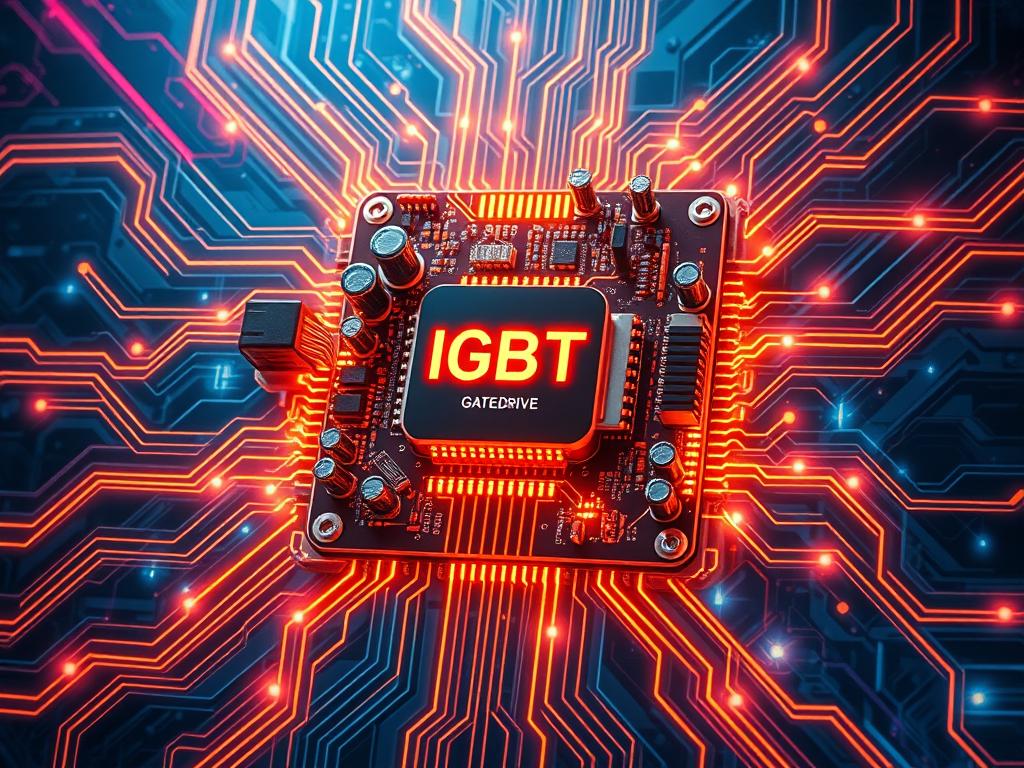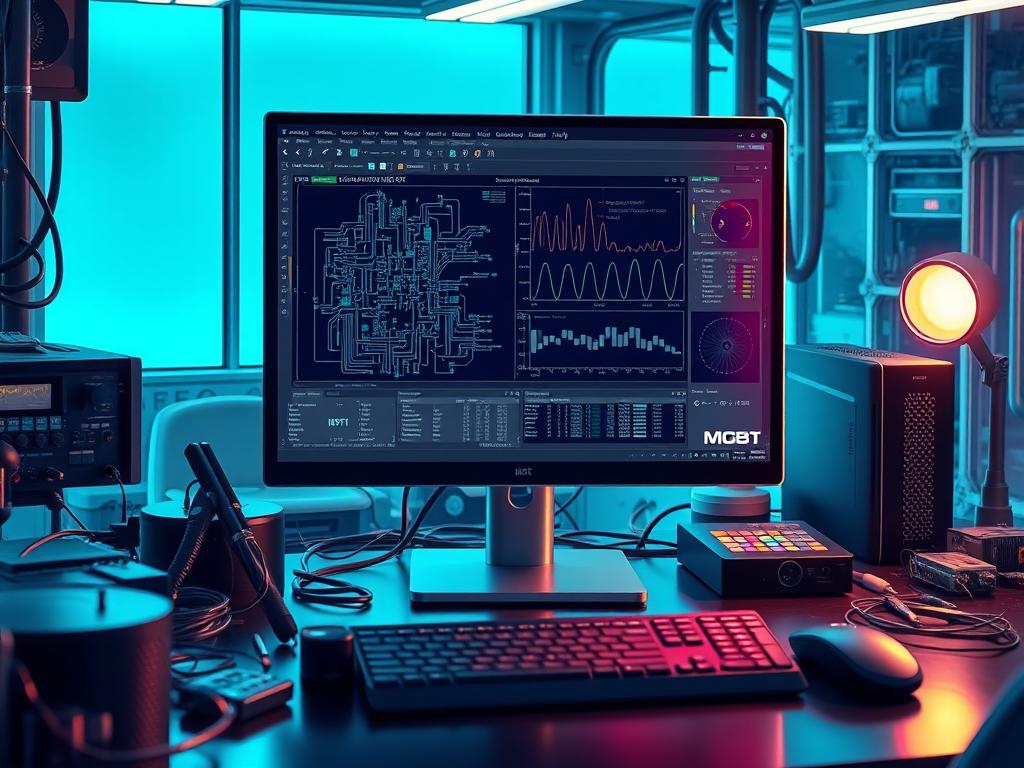In the world of power electronics, the Insulated Gate Bipolar Transistor (IGBT) stands out. It was created by Jayant Baliga in 1979. IGBTs are key in many areas, like motor controls, inverters, and electric vehicles.
IGBTs mix the strengths of Bipolar Junction Transistors (BJTs) and Metal-Oxide-Semiconductor Field-Effect Transistors (MOSFETs). They help engineers make fast and efficient power circuits. IGBTs are known for their high input impedance and ability to handle lots of current.
In the last 20 years, IGBTs have brought big savings and environmental gains. They’ve saved consumers $15.8 trillion and cut carbon dioxide emissions by 78 trillion pounds. This shows how important IGBTs are for the future of power electronics.
Key Takeaways
- IGBTs combine the advantages of BJTs and MOSFETs, offering high input impedance and exceptional current-handling capabilities.
- IGBTs are widely used in a variety of power-driven applications, including motor controls, inverters, and lighting systems.
- The adoption of IGBTs has led to significant economic and environmental benefits, saving consumers trillions of dollars and reducing greenhouse gas emissions.
- Understanding the unique characteristics and design considerations of IGBTs is crucial for engineers to create ultra-responsive and efficient power circuits.
- Continuous advancements in IGBT technology are paving the way for even more innovative and sustainable power electronics solutions.
Introduction to IGBTs in Power Circuits
Insulated Gate Bipolar Transistors (IGBTs) are key in today’s power electronics. They combine the best of MOSFETs and BJTs. This makes them essential in many power circuit applications. They offer high efficiency and ultra-responsive performance in IGBT basics power conversion and control.
Overview of Insulated Gate Bipolar Transistors
IGBTs have a special design. They use a short-channel MOSFET structure and a wide-base p-n-p BJT. This design lets IGBTs handle more current and have lower voltage drops than traditional MOSFETs. Their insulated gate structure means they can be controlled by voltage, making them very efficient in high-power applications.
Importance of Ultra-Responsive Designs
IGBTs can switch quickly and with low losses. This is key for high-efficiency power conversion circuits. Ultra-responsive IGBT designs help save energy, cut costs, and reduce environmental impact. They are used in many electronics, like motor controls and compact fluorescent lamps.
Applications of IGBTs in Modern Electronics
- Motor drives and variable-frequency drives (VFDs)
- Uninterruptible power supplies (UPS)
- Welding equipment
- Induction heating systems
- Compact fluorescent lamps (CFLs)
- Solar inverters and wind turbine converters
IGBTs are vital in many modern power circuit applications. They are used in industrial automation, renewable energy systems, and more.
Key Characteristics of IGBTs
Insulated Gate Bipolar Transistors (IGBTs) are special semiconductor devices. They mix the good points of bipolar transistors and power MOSFETs. IGBTs have top-notch IGBT specifications, like high voltage ratings and current capacity. This makes them great for many power electronics jobs.
Voltage Ratings and Current Capacity
IGBTs can take on high voltage ratings, from a few hundred volts to several kilovolts. They’re perfect for high-power tasks like motor drives, inverters, and power converters. Also, IGBTs can handle a lot of current, which is key for efficient power control.
Switching Speed and Efficiency
The switching characteristics of IGBTs depend on the movement of minority carriers. This makes them slower than power MOSFETs. But, new IGBT designs, like trench structures and field-stop technologies, have made them more efficient.
Thermal Performance and Management
IGBTs can get very hot when they work. Good heat management is vital for their performance and reliability. Using heat sinks, cooling systems, and thermal monitoring helps manage the heat.

“The on-state voltage drop across an IGBT is the sum of a diode drop across the P-N junction and the voltage drop across the driving MOSFET.”
Knowing the IGBT specifications, like voltage ratings, current capacity, switching characteristics, and thermal needs, helps designers. They can then make their power electronics circuits work better and more efficiently.
Design Considerations for IGBT Circuits
Creating high-performance IGBT circuits needs careful attention to many factors. These include choosing the right components, designing the PCB layout, and ensuring proper grounding. These steps are key to making IGBT circuits work well, efficiently, and reliably.
Selection of Components and Materials
Choosing the right components and materials is very important for IGBT circuits. IGBTs come in different voltage ratings, from 50V to 100V for the DC link. This affects the choice of other components, like MOSFETs.
The introduction of logic-level MOSFETs has helped solve design challenges. For example, the IRL640 from International Rectifier is a 5V, 200V MOSFET. It makes designing gate drive circuits easier.
One big problem in IGBT circuit design is shoot-through in one half-bridge leg. This can cause MOSFET failures. So, designing the gate drive circuit correctly is very important to avoid these failures.
PCB Design Rules for IGBT Applications
The PCB layout for IGBT circuits must follow specific rules for the best performance and reliability. The layout should reduce parasitic inductances and capacitances. These can affect switching behavior and cause EMI issues.
It’s important to think carefully about trace routing, component placement, and layer stackup. This ensures a well-designed IGBT circuit.
Importance of Grounding and Shielding
Proper grounding and shielding are crucial in IGBT circuit design. Bad grounding can cause ground loops, leading to EMI and signal integrity problems. Shielding, like using Faraday cages, helps fight electromagnetic interference. This ensures IGBT-based power electronics work reliably.
“Designing IGBT circuits requires a deep understanding of component characteristics, PCB layout techniques, and grounding principles to achieve optimal performance and reliability.”
Circuit Topologies Using IGBTs
Insulated Gate Bipolar Transistors (IGBTs) are key in power electronics. They are used in inverters and motor drive circuits. IGBTs are found in common emitter and collector setups, and in half-bridge and full-bridge converters.
Common Emitter and Collector Configurations
The common emitter and common collector IGBT setups are common in power electronics. They handle voltage and current well, fitting many needs. The choice between them depends on the circuit’s needs, like voltage and current levels.
Half-Bridge and Full-Bridge Converters
Half-bridge and full-bridge converters are also popular with IGBTs. Half-bridge converters are cost-effective for many uses. Full-bridge converters can produce more power, with positive, zero, and negative voltages.
Applications in Inverters and Motor Drives
IGBTs are great for inverter applications and motor drive circuits. They are efficient, switch fast, and handle power well. IGBT-based inverters are key in electric vehicles and renewable energy systems.
IGBT power converters are also becoming more popular. They use power cells, making systems more reliable and cost-effective. This design also supports multilevel inverters (MLIs) and scalability for various power needs.
Thermal Management Strategies
Effective IGBT thermal management is key for reliable and efficient power electronics circuits. Choosing the right heat sinks and cooling systems is important. Also, using smart heat dissipation methods can boost IGBT thermal performance.
Selecting Heat Sinks and Cooling Systems
The right heat sink and cooling system are crucial for IGBT thermal management. You need to think about the IGBT’s power, the environment, and space. Glueing the board on a heatsink can lower thermal resistance to under 40 K/W, saving space.
Design Techniques for Heat Dissipation
Using new heat dissipation methods can improve IGBT circuit thermal performance. Making the device footprint 6mm bigger around the IGBT can cut thermal resistance to 10 K/W. This lets devices handle up to 6W of power. PCB technology is also great for IGBT thermal management because it’s flexible, cost-effective, and integrates well.
Monitoring and Controlling Temperature
Temperature control is vital to avoid thermal runaway and extend IGBT life. Keeping an eye on IGBT junction temperature and using smart control can ensure top IGBT thermal management. This is especially important in high-power, high-density applications.
“Thermal management is crucial due to increasing power densities in modern electronic systems.”
By using these IGBT thermal management strategies, designers can make IGBTs work at their best. This leads to efficient and reliable power electronics circuits for many applications.
Driving Techniques for IGBTs
The performance of Insulated-Gate Bipolar Transistors (IGBTs) depends a lot on their gate drive circuits. These circuits are key to making IGBTs work well in high-power situations. Let’s look at the main parts of driving IGBTs.
Gate Drive Circuit Requirements
The gate drive circuit for an IGBT needs to give the right voltage and current. It must help the transistor switch on and off right, cut down on losses, and handle electromagnetic interference (EMI).
Isolation Techniques in Gate Driving
In high-voltage IGBTs, keeping things isolated is very important. The gate drive circuit must stay separate from the high-voltage part to keep everyone safe. Ways to do this include using gate drive transformers, opto-couplers, and isolated power.
Optimum Gate Resistor Selection
The right gate resistor is key for fast switching and less EMI. A bigger resistor can cut down on losses but might increase EMI. A smaller one can make switching faster but might also raise EMI. Designers need to find the perfect resistor value for the best performance and less EMI.
| Characteristic | Ideal Value | Impact on Performance |
|---|---|---|
| Gate Resistor | Optimized for Application | Balances switching speed and EMI generation |
| Isolation Techniques | Effective Isolation | Ensures safety and protects control electronics |
| Gate Drive Circuit | Provides Necessary Voltage and Current | Enables efficient and reliable IGBT operation |
By focusing on these key areas, engineers can make IGBT-based power circuits that work great. They will be efficient, safe, and reliable. This will help IGBTs be used in many high-power applications.

Control Methods for IGBT Circuits
In power electronics, insulated gate bipolar transistors (IGBTs) are key. They help control systems work better. Advanced control methods like PWM, feedback control, and anti-reflective strategies are used.
PWM (Pulse Width Modulation) Techniques
PWM is a common method for IGBT power converters. It controls the voltage pulses to the IGBT gate. This makes power conversion efficient and precise.
PWM techniques like sinusoidal PWM and space vector PWM improve efficiency and reduce EMI. They make power systems better.
Feedback Control Mechanisms
Feedback control is vital for IGBT circuits. It keeps systems stable and performs well. Current-mode, voltage-mode, and hybrid control schemes are used.
These methods monitor and regulate current, voltage, and power. They ensure tight regulation and better dynamic response.
Anti-Reflective Control Strategies
IGBTs can cause voltage spikes and ringing. Anti-reflective strategies like active clamping and snubber circuits help. They reduce voltage overshoots and EMI.
These techniques improve power quality in IGBT systems. They make systems more reliable and efficient.
| IGBT Control Method | Key Characteristics | Applications |
|---|---|---|
| Pulse Width Modulation (PWM) |
|
|
| Feedback Control Mechanisms |
|
|
| Anti-Reflective Control Strategies |
|
|
Advanced IGBT control methods make power electronics circuits better. They use PWM techniques, feedback control, and anti-reflective strategies. This unlocks IGBTs’ full potential in modern applications.
Simulation Tools for Circuit Design
Designing IGBT circuits needs a deep understanding of the device and how it behaves. Simulation tools are key in this process. They help engineers predict how IGBT circuits will work, improve designs, and ensure they operate well.
Popular Software for IGBT Simulation
TINA is a top choice for IGBT simulation software. It has over 20,000 parts and models that users can customize. TINA also has virtual tools like a digital multimeter and oscilloscope for testing circuits.
Importance of Accurate Modeling
Getting IGBT characteristics right is crucial for good simulations. TINA offers a wide range of components, from simple parts to complex devices. This lets engineers create detailed models and check their IGBT designs.
Running Simulations for Optimal Design
Simulations help engineers fine-tune their IGBT circuit designs and see how they’ll perform. TINA’s tools, like the Flowchart Editor, make it easier to develop and test designs.
In summary, tools like TINA are vital for IGBT circuit design. They offer a platform for IGBT simulation software, accurate modeling, and design optimization. With these tools, engineers can create high-performance power circuits for today’s electronics.
| Feature | Description |
|---|---|
| Library Components | TINA offers over 20,000 parts and manufacturer models that can be customized by users. |
| Virtual Instruments | TINA includes a digital multimeter, function generator, oscilloscope, and other virtual measurement tools. |
| Modeling Capabilities | TINA supports modeling of passive and active components, including resistors, capacitors, transistors, and operational amplifiers. |
| Design Optimization | TINA’s simulation capabilities enable engineers to optimize IGBT circuit designs and predict their performance. |

“Simulation tools are essential for IGBT circuit design, as they provide a platform for accurate modeling and comprehensive design optimization.”
Testing and Validation of IGBT Circuits
Testing and validation are key in designing IGBT-based power circuits. Electronics engineers use various test equipment and methods. This ensures the circuit works well under different conditions and finds issues early.
Essential Test Equipment and Methods
For IGBT circuit validation, oscilloscopes, curve tracers, and thermal imaging cameras are crucial. Oscilloscopes help analyze switching waveforms, checking important details like rise/fall times and switching losses. Curve tracers give detailed info on IGBT performance, and thermal cameras spot hot spots and monitor temperature.
Reliability Testing Protocols
Reliability testing is vital for IGBT circuits’ long-term performance. It involves stress tests like temperature cycling and power cycling. Engineers watch IGBT characteristics over time to ensure they can handle real-world use and last as long as needed.
Performance Benchmarking Techniques
Engineers use benchmarking to check if IGBT circuits meet standards and goals. They compare efficiency, switching speed, and thermal management to benchmarks. This helps validate performance and find ways to improve.
Testing and validation of IGBT circuits are essential in design. They ensure these components perform well, reliably, and efficiently in real use. A thorough testing approach helps unlock IGBT technology’s full potential and drives innovation in power electronics.
Common Design Challenges and Solutions
Designing efficient and reliable power circuits with Insulated Gate Bipolar Transistors (IGBTs) has its challenges. Engineers face issues like switching losses, electromagnetic interference (EMI) mitigation, and protection against voltage spikes.
Overcoming Switching Losses
IGBT switching losses can hurt a power circuit’s efficiency. To fix this, engineers use soft-switching techniques. These include zero-voltage switching (ZVS) or zero-current switching (ZCS). They reduce energy loss during switching.
Snubber circuits are another solution. They help control voltage and current spikes during switching. Designing snubbers well can cut down switching losses a lot.
EMI and RFI Mitigation Techniques
IGBT switching can cause electromagnetic and radio-frequency interference. This can mess with nearby electronics. Designers use proper layout and shielding techniques to solve this. They optimize PCB design and use grounding and shielding.
Filtering components like common-mode chokes and EMI filters also help. They reduce emissions, meeting EMC standards.
Protection Against Voltage Spikes
Voltage spikes can damage IGBT devices. To protect against this, designers add overvoltage protection circuits. These include clamping diodes and varistors. They absorb spike energy, saving the IGBT.
By tackling these challenges, engineers make IGBT circuits efficient and reliable. These circuits meet the needs of today’s power conversion.

Safety Considerations in IGBT Design
Ensuring safety is key in designing Insulated Gate Bipolar Transistor (IGBT) circuits. It’s important to know about fault conditions and use safety circuits. IGBT safety design must follow industry standards and rules to protect everyone.
Understanding Fault Conditions
IGBT circuits can face different faults that might cause failures and dangers. These include overcurrent, overvoltage, and thermal runaway. It’s vital to address these in the IGBT safety design.
Implementation of Safety Circuits
Strong safety circuits are needed to handle IGBT faults. They include desaturation protection, overcurrent sensing, and thermal monitoring. These help quickly spot and fix faults, ensuring fault protection and safety.
Standards and Regulations Compliance
Following safety standards and rules is critical in IGBT design. Standards like IEC 60747-9 guide safe and reliable use of power devices. This ensures regulatory compliance and focuses on user safety.
| Fault Condition | Potential Consequences | Safety Circuit Measures |
|---|---|---|
| Overcurrent | Component damage, fire, explosion | Overcurrent sensing, current limiting |
| Overvoltage | Insulation breakdown, component failure | Overvoltage protection, voltage clamping |
| Thermal Runaway | Overheating, component degradation | Thermal monitoring, active cooling |
By knowing about faults, using strong safety circuits, and following safety standards, designers can make safe IGBT circuits. This protects both the device and the user from risks.
The Future of IGBT Technology
The future of Insulated Gate Bipolar Transistors (IGBTs) is very promising. IGBT technology has led power electronics for years. Researchers are always looking for ways to make it better and more efficient.
Trends in IGBT Development
Improving power density and efficiency is a big trend in IGBTs. Companies are working with Silicon Carbide (SiC) and Gallium Nitride (GaN) to boost performance. This could change how we use power in devices and motors, making them more efficient and saving energy.
Integration with Emerging Technologies
IGBTs are getting smarter, thanks to new tech like AI and edge computing. DeepX is leading the way with AI chips that are powerful yet energy-efficient. This mix of IGBTs and advanced computing could lead to smarter systems and robots.
Environmental Impact and Sustainability
Making power electronics greener is a big goal. IGBTs are at the heart of this effort. By using cleaner materials and processes, IGBTs can help reduce carbon emissions. This move towards sustainability is expected to make the industry more eco-friendly.
The future of IGBT technology is exciting. With a focus on better performance, integration with new tech, and being green, IGBTs will shape the future of power electronics.

“The strategic entry of DeepX into the AI semiconductor market aims to address the demand for on-device AI and the limitations of cloud-based AI systems, particularly in industries like smart cities, healthcare, and autonomous robotics.”
Real-World Case Studies
Insulated Gate Bipolar Transistors (IGBTs) are key in many industrial fields. They are used in a variety of ways, showing their power and versatility. We’ll look at some examples of how IGBTs have been used successfully and what we can learn from any challenges.
Successful IGBT Applications in Industry
IGBTs have been a game-changer in high-power motor drives for industrial automation. Their fast switching and high efficiency have led to the creation of smaller, more reliable, and energy-saving systems. IGBT case studies show how these devices improve processes, cut downtime, and boost productivity.
In renewable energy, like solar inverters and wind turbine converters, IGBTs shine. They handle high voltages and currents well and manage heat well. This has made power conversion systems more efficient and reliable. These industrial applications have helped the renewable energy sector grow.
Lessons Learned from Design Failures
Even with success stories, we can learn from IGBT failures. For example, not managing heat properly can cause IGBTs to fail early. It shows how crucial good thermal design is. Also, poor gate driver circuits or bad switching patterns can lead to high losses, highlighting the need to understand IGBT control better.
Innovative Solutions Implemented
As IGBT technology advances, engineers find new ways to tackle challenges. They use better thermal management, like heat sinks and cooling systems, to boost power density and reliability. They also add smart protection and control algorithms to improve performance and safety.
These case studies highlight IGBTs’ role in industry, lessons from failures, and new solutions. They show how IGBTs are changing power electronics and driving progress.
Conclusion
IGBTs are key in high-power, efficient switching. Research aims to boost their performance and reliability. This will lead to more advanced power circuits.
Summary of Key Points
We’ve looked into IGBT design’s details. Topics include characteristics, design, and thermal management. We also talked about simulation tools and common challenges.
Future Outlook for IGBT-Centric Designs
IGBT technology is set to improve. Expect faster switching, less loss, and better thermal management. As the demand for power transistors grows, designs will get smarter. They’ll focus on saving energy and protecting the environment.
Final Thoughts on Designing Ultra-Responsive Circuits
Creating ultra-responsive circuits with IGBTs needs deep knowledge. Keeping up with IGBT trends is crucial. This will help unlock their full potential, making electronics more efficient and reliable.
“The future of power electronics lies in the continued advancement and integration of IGBT technology, driving towards ever-more responsive, efficient, and sustainable power systems.”
We end our deep dive into IGBT design with excitement. The future of ultra-responsive power circuits is bright. The journey ahead is full of endless possibilities.
Additional Resources
Looking to learn more about IGBT-based power electronics design? There are many resources out there. Books like “The IGBT Device” by B. Jayant Baliga offer deep insights and design tips. Online courses on platforms like Coursera and edX also cover IGBT technology and its uses in today’s electronics.
Professional groups like the IEEE Power Electronics Society are great for those in the field. They offer a place to share knowledge, meet others, and learn about new developments. This helps professionals keep up with the fast pace of power electronics.
Whether you’re an engineer, student, or hobbyist, there’s a lot to learn about IGBTs. The wide range of resources available can help you understand more, improve your skills, and stay current in ultra-responsive power circuit design.


